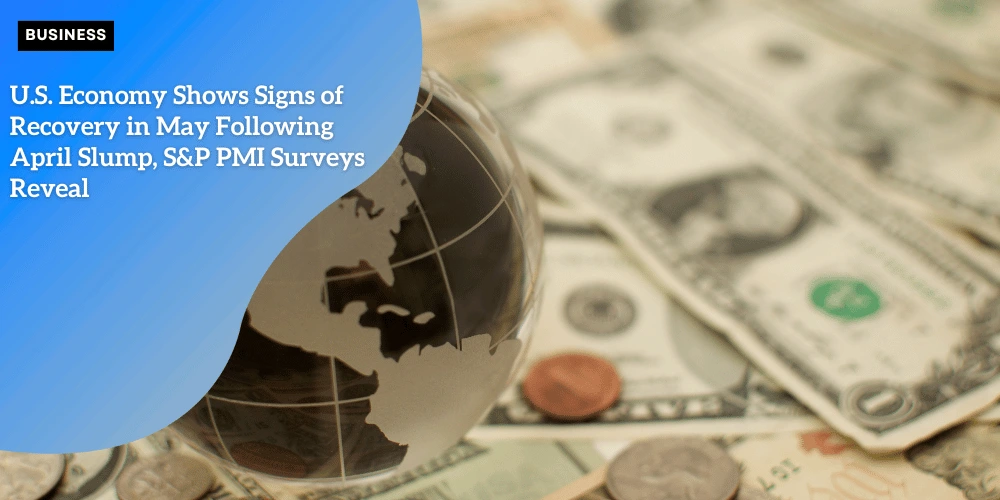U.S. Economy Shows Signs of Recovery in May Following April Slump, S&P PMI Surveys Reveal

Anúncios
In May, the U.S. economy displayed promising signs of recovery after a challenging slump in April, as reflected in the latest data from S&P’s Purchasing Managers Index (PMI) surveys.
The surveys revealed significant improvements in business activity across both manufacturing and services sectors.
Although the prices of goods and services rose sharply, the data indicates that the U.S. economy is recovering, with growth indicators showing a positive trend.
U.S. Business Activity Bounces Back in May
According to the latest flash reports from S&P, the U.S. manufacturing PMI rose to 52.3 in May, reaching a three-month high.
Anúncios
This was a notable rebound after a period of sluggish growth, signaling an improvement in manufacturing activity.
The manufacturing sector’s PMI exceeded expectations, as economists had predicted a slight decline to 49.8 for May, indicating a possible contraction.
A PMI value above 50 signifies growth, so the uptick to 52.3 suggests that the sector is back on track after a challenging previous month.
Anúncios
Similarly, the U.S. services PMI also rose to 52.3 in May, marking a two-month high.
This was a significant recovery from the previous month’s figure of 50.8. Like manufacturing, services are experiencing growth, which is a positive sign for the broader economy.
The higher-than-expected increase in both indices indicates that business activity in the U.S. is picking up after the slow pace observed in April.
Price Hikes Point to Consumer Price Increases
While the growth in business activity is promising, the data also reveals a concerning rise in prices.
The prices for goods and services in May saw their largest increase since August 2022.
This uptick in prices suggests that inflationary pressures are intensifying, which could lead to further consumer price hikes in the near future.
As businesses face higher input costs, the expectation is that consumers may soon feel the effects in the form of increased prices for everyday goods and services.
The increase in prices comes at a time when the U.S. Federal Reserve is closely monitoring inflation trends.
The rise in prices may prompt further policy tightening, such as interest rate hikes, in an effort to manage inflation and stabilize the economy.
However, these measures can also slow down economic growth by increasing borrowing costs for consumers and businesses.
Employment Trends and Economic Sentiment
The May surveys also highlighted some mixed signals in the employment sector.
After a strong performance in March and April, employment levels in May saw a slight decline.
This minor drop suggests that, while the economy is recovering, labor market conditions remain somewhat uncertain.
The reduction in employment could be a temporary blip or a sign of ongoing challenges in certain industries.
However, despite the slight dip in employment, there is a rebound in overall sentiment about the economy’s future prospects.
The survey revealed that sentiment regarding future output has increased to the highest level since January. This shift in outlook suggests that businesses are becoming more confident about the economic recovery, driven by the recovery in manufacturing and services activity.
Companies are looking forward to a more stable economic environment, bolstered by the reduction of trade tensions between the U.S. and China.
Key Drivers of Economic Recovery
Several factors appear to be driving the U.S. economic recovery in May.
One of the most notable drivers is the easing of trade tensions with China.
According to Samuel Tombs, chief U.S. economist at Pantheon Macroeconomics, the improvement in business activity partly reflects relief stemming from the suspension of tariffs between the U.S. and China.
This bilateral trade deal, which temporarily halts the imposition of tariffs for 90 days, has helped reduce concerns about the negative impact of trade wars on global supply chains.
As a result, businesses have been able to focus more on production and growth rather than on navigating tariff-related challenges.
The easing of trade tensions has also led to a reduction in supply shortages and disruptions, which had been contributing to inflationary pressures.
Businesses, particularly in the manufacturing sector, are now in a better position to accumulate inventories, which rose sharply in May.
The surveys found that manufacturing input inventories experienced their largest accumulation on record.
This surge in inventory building is seen as a direct response to concerns over potential supply shortages, which had plagued companies in previous months.

Inflationary Pressures and Supply Chain Concerns
Despite the positive growth signs, inflation remains a key concern for the U.S. economy. The May PMI surveys revealed that supply chain disruptions and price increases due to tariffs are still causing inflationary pressures.
Chris Williamson, chief business economist at S&P Global Market Intelligence, noted that the accumulation of input inventories was the largest ever recorded since the surveys began 18 years ago.
This accumulation of goods suggests that businesses are trying to safeguard against further supply chain disruptions and price increases.
While these efforts to stockpile inventory may help alleviate some immediate supply concerns, they also contribute to rising costs, which can be passed on to consumers.
The larger-than-expected jump in prices could lead to additional inflationary pressures in the months to come, particularly if global supply chains remain under strain.
A Stronger Economic Outlook for the U.S.?
Looking at the big picture, the latest data from the S&P PMI surveys provides a mixed but encouraging view of the U.S. economy.
While inflationary pressures and supply chain challenges persist, the improvement in business activity, particularly in manufacturing and services, signals that the economy is recovering.
The relief from trade tensions between the U.S. and China, combined with an optimistic outlook for future output, suggests that the worst may be behind the U.S. economy.
However, the rise in prices and the slight dip in employment remain significant concerns.
As the economy continues to recover, policymakers will need to balance efforts to manage inflation with the need to support continued growth.
The Federal Reserve’s next moves on interest rates and other monetary policies will likely play a key role in shaping the economic trajectory in the coming months.
Conclusion
The May S&P PMI surveys paint a picture of cautious optimism for the U.S. economy.
After a period of stagnation in April, the improvement in business activity across both manufacturing and services sectors is a positive sign.
However, the sharp rise in prices and the accumulation of inventories indicate that inflationary pressures are still a significant challenge.
The easing of trade tensions between the U.S. and China has provided relief to businesses, helping to reduce supply chain disruptions and improve economic sentiment.
Yet, concerns over inflation and potential price hikes remain a key issue that could affect consumers in the near future.
As the economy continues to recover, it will be crucial to monitor both the ongoing improvements in business activity and the challenges posed by inflation and labor market dynamics.
Overall, while the U.S. economy shows signs of rebounding in May, the path to sustained recovery remains uncertain, and both businesses and policymakers will need to navigate these challenges carefully to ensure long-term economic stability.

